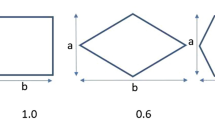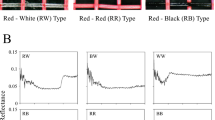Abstract
Spread of the aphid-transmitted cucumber mosaic virus (CMV) and potato virus Y (PVY) in pepper plots was markedly reduced by growing the plants under a white coarse-net cover permitting normal development of the plants. This net also reduced the winged aphid population on the plants by more than 40 times. Light grey and yellow nets also reduced virus spread and aphid populations, but were much less effective than white ones. The nets do not act as a mechanical barrier to aphids. It is suggested that under white and grey netting, aphid repellency and microclimatic conditions are the primary causes of virus check, while the controlling effect of the yellow nets may be explained by their being more attractive to aphids than the plants. A reduction of “background effect” and a limiting of the aphids’ vision range by nets are probably other factors involved in the protective mechanism.
Similar content being viewed by others
References
Cohen, S. and Marco, S. (1973) Reducing the spread of aphid-transmitted viruses in peppers by trapping the aphids on sticky yellow polyethylene sheets.Phytopathology 63: 1207–1209.
Kring, J.B. (1972) Flight behavior of aphids.A. Rev. Ent. 17: 461–492.
Loebenstein, G., Alper, M., Levy, S., Palevitch, D. and Menagem, E. (1975) Protecting peppers from aphid-borne viruses with aluminum foil or plastic mulch.Phytoparasitica 3: 43–53.
Rylski, I. and Spigelman, M. (1979) [Pepper production under shaded conditions. Report 1978/79.] p. 31. Div. of Vegetable Crops, Agricultural Research Organization, The Volcani Center, Bet Dagan, Israel. (in Hebrew; mimeo.)
Shifriss, C. and Marco, S. (1974) [“Maor”, a new pepper variety for export and the local market, resistant to potato virus Y (PVY).]Hassadeh 54: 864. (in Hebrew)
Siegel, S. (1956) Non-parametric Statistics for the Behavioral Sciences. McGraw-Hill, New York, NY.
Smith, F.F. and Webb, R.E. (1969) Repelling aphids by reflective surfaces: New approach to control of insect-transmitted viruses.in: Maramorosch, M. [Ed.] Viruses, Vectors and Vegetation. pp. 631–639. Interscience Publishers, New York, NY.
Smith, J.G. (1976) Influence of crop background on aphids and other phytophagous insects on Brussels sprouts.Ann. appl. Biol. 83: 1–13.
Vanderveken, J.J. (1977) Oils and other inhibitors of non-persistent virus transmission.in: Harris, H.F. and Maramorosch, K. [Eds.] Aphids as Virus Vectors. pp. 435–454. Academic Press, New York, NY.
Weiss, M. (1976) [Trials in controlling virus diseases in vegetable crops by luring aphid vectors to sticky color traps.] M.Sc. thesis, Faculty of Agriculture, The Hebrew University of Jerusalem, Rehovot, Israel (in Hebrew)
Author information
Authors and Affiliations
Additional information
Publication of the Agricultural Research Organization. No. 335-E, 1980 series.
Rights and permissions
About this article
Cite this article
Cohen, S. Reducing the spread of aphid-transmitted viruses in peppers by coarse-net cover. Phytoparasitica 9, 69–76 (1981). https://doi.org/10.1007/BF03158331
Received:
Revised:
Issue Date:
DOI: https://doi.org/10.1007/BF03158331




